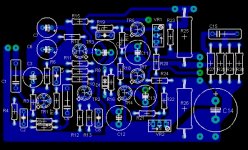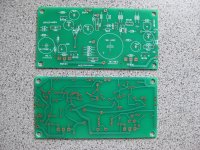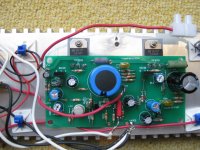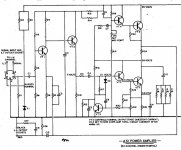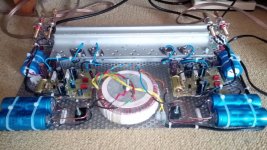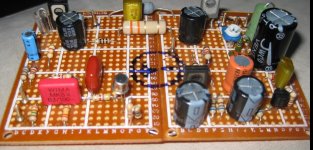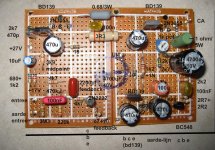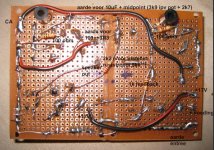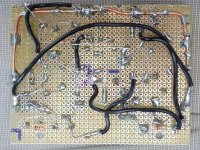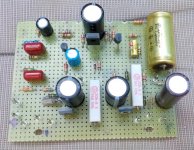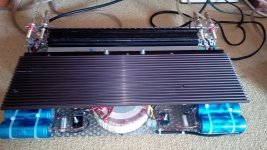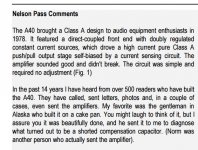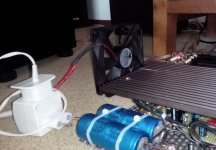Jez,
I particularly liked this:
I will go there one day and let you know.
Do you realise the word 'dinkum' is a southern Chinese dialect meaning 'The Genuine Article'?
So much for Australian, came here in the 1850s goldrush.....
Now, OT, there is frequent debate that printed circuits do not sound that wonderful. Of course, some are not well designed, so parasitics might indeed be worse, but tag strips can and often do sound marvellous.
Cheers,
Hugh
I particularly liked this:
Chester White is the bistro that everyone wishes would open in their neighbourhood – great quality food, a relaxed, unpretentious atmosphere, generous hospitality, a timeless sense of style and great value.
Simon Arkless delivers confident, flavoursome food in an accessible menu with French and Spanish influences, sitting comfortably alongside sensational pizzas and some classics that tick all the boxes.
I will go there one day and let you know.
Do you realise the word 'dinkum' is a southern Chinese dialect meaning 'The Genuine Article'?
So much for Australian, came here in the 1850s goldrush.....
Now, OT, there is frequent debate that printed circuits do not sound that wonderful. Of course, some are not well designed, so parasitics might indeed be worse, but tag strips can and often do sound marvellous.
Cheers,
Hugh
At high RF frequencies the dielectric effect of the PCB material would certainly have an effect... sometimes utilised as part of the design to make stripline etc. At audio frequencies I fail to see how one should be any different to the other if in both cases good practice is followed in layout etc. There is certainly nothing wrong with tagstrip and I've used it many times myself, even to build solid state power amps.
Yeh let me know what the young 'uns grub is like if you get there... ain't seen him for quite a few years actually!
Jez.
Yeh let me know what the young 'uns grub is like if you get there... ain't seen him for quite a few years actually!
Jez.
Hi Scafas,
Not really being an electronics major how would people suggest to improve Scatas's layout, as I'm just a second timer in this subject? This is meant to be a constructive comment please take it as such.
Myself I worry about parasitic osculations in your PCB deisgn as AKSA warns.
Since the design is likely to be a small run, you should forget mass production objectives of a smallest possible PCB. Shaving off 5-10 Euros in cost of PCB manufacture and potentially getting parasitic osculations as a poor compromise. I think AKSA's fear of parasitic osculations should be a big concern for me also.
For me a PCB has to be better than strip board, (called Veroboard when I was at school). From playing with strip board I would like a greater space between tracks and am quiet willing to be convinced into having a large earthed area around each track. I guess I have to leave PCB design to the more experienced.
Having never used tag board what other reasons do people favor tag board? It appeals to me as I can buy it off the shelf rather than have to make it, for the same reason I have used strip board.
Regards
Owen
Not really being an electronics major how would people suggest to improve Scatas's layout, as I'm just a second timer in this subject? This is meant to be a constructive comment please take it as such.
Myself I worry about parasitic osculations in your PCB deisgn as AKSA warns.
In most cases, tagboard amps will sound better than pcbs anyway because of lower parasitics. I hear this again and again.
Since the design is likely to be a small run, you should forget mass production objectives of a smallest possible PCB. Shaving off 5-10 Euros in cost of PCB manufacture and potentially getting parasitic osculations as a poor compromise. I think AKSA's fear of parasitic osculations should be a big concern for me also.
For me a PCB has to be better than strip board, (called Veroboard when I was at school). From playing with strip board I would like a greater space between tracks and am quiet willing to be convinced into having a large earthed area around each track. I guess I have to leave PCB design to the more experienced.
Having never used tag board what other reasons do people favor tag board? It appeals to me as I can buy it off the shelf rather than have to make it, for the same reason I have used strip board.
Regards
Owen
SOLVED my own design A51 pcb
Finally I got the courage to make my own design. I decided to order a small series of the pcb's (to get a reasonable cost per unit). I misused a ACA pass cabinet to install my A21/51 with laptop smps (I guess the first and only A51 in the world on a 24V smps).
I have 2 sets of pcb's left. I'm asking € 35 for the set of 2 pieces (to cover a part of my bigger expenses). If you are interested you can mail me. If more people are interested I can make a new order/batch, but that will take another 6 weeks or so to finish production.
Finally I got the courage to make my own design. I decided to order a small series of the pcb's (to get a reasonable cost per unit). I misused a ACA pass cabinet to install my A21/51 with laptop smps (I guess the first and only A51 in the world on a 24V smps).
I have 2 sets of pcb's left. I'm asking € 35 for the set of 2 pieces (to cover a part of my bigger expenses). If you are interested you can mail me. If more people are interested I can make a new order/batch, but that will take another 6 weeks or so to finish production.
Attachments
the journey never ends I guess
Just for fun I was testing my diy musical fidelity A1 with my old Sugden A51 (also diy, see first posts). Both amps sound good to me if you like a vintage warm lush sound (tubey some would say) with airy highs, big soundstage and round mid/bass. The A1, though on the warm side, sounds more modern to me than the Sugden. Probably something to do with the output caps in combination with the single power rail of the A51.
(Of course all this is dependent on your speakers, source, acoustics, personal judgment, lay-out, solder skills, quality of components and diy-bias .... and endless game of joy ánd frustration I must confess).
Nothing better to do and many spare parts lying around: why not mixing some parts into yet another A21 on breadboard type thing. So nothing fancy, just hobbying around and testing stuff. Tough I have the ready made PCB's that look nice available, I wanted to try different components to tune the sound still more. So I went for made by hand handwiring oldstyle breadboarding on veroboard.
I will spare you the details. I did as many as 40-50 variations. That's the reason you can see some remainings of mods on the boards. In the end I went back to the all-original circuit of the A21 Richard Allen that at the time had a lengthy way of getting the idle current right (using hand selected diodes, see the articles of connaisseur Jim Lesurf at Richard Allan Class A amplifiers).
Wow, this circuit has some magic! I found out that building this original circuit of RA with modern diodes is not a problem at all (no matching needed, all diodes I tried were spot-on). I will not go into the discussion of which amp is best but for sure this amp is something special and works as beautifully now in 2016 as it did 50 years back.
But nobody in diy-land gives a **** about these old designs (so it seems). Funny though that wooden A21's fetch quite high prices secondhand. And modern versions of the Sugden circuit with some fancy enclosure are sold up to this day for quite modern prices too.
Just for fun I was testing my diy musical fidelity A1 with my old Sugden A51 (also diy, see first posts). Both amps sound good to me if you like a vintage warm lush sound (tubey some would say) with airy highs, big soundstage and round mid/bass. The A1, though on the warm side, sounds more modern to me than the Sugden. Probably something to do with the output caps in combination with the single power rail of the A51.
(Of course all this is dependent on your speakers, source, acoustics, personal judgment, lay-out, solder skills, quality of components and diy-bias .... and endless game of joy ánd frustration I must confess).
Nothing better to do and many spare parts lying around: why not mixing some parts into yet another A21 on breadboard type thing. So nothing fancy, just hobbying around and testing stuff. Tough I have the ready made PCB's that look nice available, I wanted to try different components to tune the sound still more. So I went for made by hand handwiring oldstyle breadboarding on veroboard.
I will spare you the details. I did as many as 40-50 variations. That's the reason you can see some remainings of mods on the boards. In the end I went back to the all-original circuit of the A21 Richard Allen that at the time had a lengthy way of getting the idle current right (using hand selected diodes, see the articles of connaisseur Jim Lesurf at Richard Allan Class A amplifiers).
Wow, this circuit has some magic! I found out that building this original circuit of RA with modern diodes is not a problem at all (no matching needed, all diodes I tried were spot-on). I will not go into the discussion of which amp is best but for sure this amp is something special and works as beautifully now in 2016 as it did 50 years back.
But nobody in diy-land gives a **** about these old designs (so it seems). Funny though that wooden A21's fetch quite high prices secondhand. And modern versions of the Sugden circuit with some fancy enclosure are sold up to this day for quite modern prices too.
Attachments
vero boards revived ...
Looking back at this thread: most reactions say that nothing wrong with veroboard vis-a-vis pcb. As you can see I have both (own designed) pcb's ánd clumsy veroboards. Maybe the clumsiness of the veroboards give the old-fashioned design (and sound ...?) more credits, blabla. In the end I returned to veroboard, mainly because they are great for experimenting and fiddling around (for me, that's big part of the hobby, gave up about building an amp and never touching it again just to listen to it).
So here a few pictures rounding up the discussion (and so you believe I actually tried some things).
Looking back at this thread: most reactions say that nothing wrong with veroboard vis-a-vis pcb. As you can see I have both (own designed) pcb's ánd clumsy veroboards. Maybe the clumsiness of the veroboards give the old-fashioned design (and sound ...?) more credits, blabla. In the end I returned to veroboard, mainly because they are great for experimenting and fiddling around (for me, that's big part of the hobby, gave up about building an amp and never touching it again just to listen to it).
So here a few pictures rounding up the discussion (and so you believe I actually tried some things).
Attachments
Awhile ago, I did quite a number on an old Sugden like you and apart from the choice of capacitors and bias structure, the power supply caps (Rifa) were a huge contributor to the final sound
Interestingly, another product from the same stable is their old cd player based on the old Phillips 1541A dac chip that still produces a remarkably musical sound, despite the low data density in comparison to many of todays systems
Interestingly, another product from the same stable is their old cd player based on the old Phillips 1541A dac chip that still produces a remarkably musical sound, despite the low data density in comparison to many of todays systems
Yes, interesting thing to find out what different components can mean for the sound (to you). Also frustrating because the combinations are endless (and so far as I know the differences cannot (most of the time) be explained or measured in objective terms).
Seem to remember that the (vintage) sound of old 70ties amps and receivers (notably the then top of the range Marantz and Sansui, prices of these items are skyhigh nowadays) also hing on the use of particular caps and some kind of carbon resistors. Of course I presume, to give them some coloration that is pleasant to listen to. Also remember to have read somewhere that owners that changed all components to more modern variants in the process of restoration (metalfilm resistors, modern caps etc) do regret the change because now the vintage amp does sound more like any other normal hifi-ish amp.
Seem to remember that the (vintage) sound of old 70ties amps and receivers (notably the then top of the range Marantz and Sansui, prices of these items are skyhigh nowadays) also hing on the use of particular caps and some kind of carbon resistors. Of course I presume, to give them some coloration that is pleasant to listen to. Also remember to have read somewhere that owners that changed all components to more modern variants in the process of restoration (metalfilm resistors, modern caps etc) do regret the change because now the vintage amp does sound more like any other normal hifi-ish amp.
happy marriage between sugden A21 and musical fidelity A1?
Here in summer heatcase temperature became too high. So I peeked around in my attic and found half of a musical fidelity top. So now this helps cooling down the temperature with 5-10 degrees.
This now is some groundplane for me to experiment with small single ended class A amplifiers. I have JLH-mini lying around that could fit the bill and the pass amp camp amp. All these can work allright with V+ of around 24V and all have roughly the same range of idle currents and dissipation.
BTW: I listened shortly to the Sugden through a 24V laptop power supply (a beefy one, around 6 Amps). But to my ears this is a few notches back for my listening pleasure. I came to the same conclusion a few years back when I had the ACA (amp camp amp) in operation (at that time I started with the laptop supplies as the ACA was designed with just that as one of the starting points).
Here in summer heatcase temperature became too high. So I peeked around in my attic and found half of a musical fidelity top. So now this helps cooling down the temperature with 5-10 degrees.
This now is some groundplane for me to experiment with small single ended class A amplifiers. I have JLH-mini lying around that could fit the bill and the pass amp camp amp. All these can work allright with V+ of around 24V and all have roughly the same range of idle currents and dissipation.
BTW: I listened shortly to the Sugden through a 24V laptop power supply (a beefy one, around 6 Amps). But to my ears this is a few notches back for my listening pleasure. I came to the same conclusion a few years back when I had the ACA (amp camp amp) in operation (at that time I started with the laptop supplies as the ACA was designed with just that as one of the starting points).
Attachments
This may sound a bit ridiculous considering the aversion this site has towards fan cooling but there are some nearly totally silent slow running fans available for just a few $s that'll be perfect for the cooling job - many of them include temperature control so you can run the Sugden at a higher bias as well
Another thing to keep in mind is that these older Sugden designs evolved in the period that was the time of analogue sources and as such, will need a bit of 'tweaking' to produce a similar sound with the digital signal (in my opinion, I add here) and will benefit from a higher bias adjustment - this also means the amp's sound will become more dependent on the quality of the power supply so more attention here should benefit the total package - some of these older amps have a certain 'musicality' about them that isn't so common these days and are probably a horror story for the guru and measurement 'experts' similar to many of the valve based devices
Another thing to keep in mind is that these older Sugden designs evolved in the period that was the time of analogue sources and as such, will need a bit of 'tweaking' to produce a similar sound with the digital signal (in my opinion, I add here) and will benefit from a higher bias adjustment - this also means the amp's sound will become more dependent on the quality of the power supply so more attention here should benefit the total package - some of these older amps have a certain 'musicality' about them that isn't so common these days and are probably a horror story for the guru and measurement 'experts' similar to many of the valve based devices
Fan cooling
Thanks James for the reply.
I can confirm all of your remarks.
When I saw the temperature rise to uncomfortable high levels (I measured around 60-65 degrees C at the fins when the environment had around 30 degrees), I firstly got down the idle current from around 800ma to 500mA. Problem solved, total dissipation for both channels down from 40 Wats to less than 30 Watts, 10 degrees down. Still hot at 55 degrees, but doable.
After some hours of listening I got the idea that the sound had changed somewhat (not to the better side of things). These things are tricky and I cannot say for sure if it's in my head only. But had the wish to go back to around 800mA to be sure.
Then I took an old 12 cm fan from a former PC and slowed down the RPM to less than 1.000. Almost silent (only to be heard with your ears next to the fan itself). I put it to blow alongside the heatsink. The temperature now stabilizes at around 40-45 degrees. I can now experiment with still higher currents (the amp camp amp and JLH go even higher to 1-1.3 Amps because they are single-ended and therefor less efficient).
Now I returned to greater heat-sink area, this also works allright, stabilising temperature at around 50 degrees C (remember the temps are extreme here now, so expect 10 degrees lower during normal times). So I can experiment with 1 Amp now without problems.
See picture for the fan that I used. The 'power supply' was salvaged from a ladyshave (12V DC). Well, that's real old fashioned mixing all kinds of rubbish from the wastebin! I think I remember that Nelson Pass once said it's this kind of flic-a-flac diy electronics he likes most.
.... I looked it up: see attachment, Nelson talking about someone who built the A40 in a cakepan (well HE did it beautifully). Really like to see some pictures of it, awesome idea.
Thanks James for the reply.
I can confirm all of your remarks.
When I saw the temperature rise to uncomfortable high levels (I measured around 60-65 degrees C at the fins when the environment had around 30 degrees), I firstly got down the idle current from around 800ma to 500mA. Problem solved, total dissipation for both channels down from 40 Wats to less than 30 Watts, 10 degrees down. Still hot at 55 degrees, but doable.
After some hours of listening I got the idea that the sound had changed somewhat (not to the better side of things). These things are tricky and I cannot say for sure if it's in my head only. But had the wish to go back to around 800mA to be sure.
Then I took an old 12 cm fan from a former PC and slowed down the RPM to less than 1.000. Almost silent (only to be heard with your ears next to the fan itself). I put it to blow alongside the heatsink. The temperature now stabilizes at around 40-45 degrees. I can now experiment with still higher currents (the amp camp amp and JLH go even higher to 1-1.3 Amps because they are single-ended and therefor less efficient).
Now I returned to greater heat-sink area, this also works allright, stabilising temperature at around 50 degrees C (remember the temps are extreme here now, so expect 10 degrees lower during normal times). So I can experiment with 1 Amp now without problems.
See picture for the fan that I used. The 'power supply' was salvaged from a ladyshave (12V DC). Well, that's real old fashioned mixing all kinds of rubbish from the wastebin! I think I remember that Nelson Pass once said it's this kind of flic-a-flac diy electronics he likes most.
.... I looked it up: see attachment, Nelson talking about someone who built the A40 in a cakepan (well HE did it beautifully). Really like to see some pictures of it, awesome idea.
Attachments
Yep, really high bias and fan cooling - anathema to the modern crowd but such a pleasant sound
I find it quite interesting that the very musicians that produce the music in the first place are fanatical about the sound of their instruments rather than technical distortion measurements and any distortion is a part of the music itself - at the 'hifi end', we tend to be quite fanatical about reproducing this original distortion extremely accurately - a bit of a conundrum, yes?!
And the vinyl/analogue revival continues unabated ....
I find it quite interesting that the very musicians that produce the music in the first place are fanatical about the sound of their instruments rather than technical distortion measurements and any distortion is a part of the music itself - at the 'hifi end', we tend to be quite fanatical about reproducing this original distortion extremely accurately - a bit of a conundrum, yes?!
And the vinyl/analogue revival continues unabated ....
- Status
- This old topic is closed. If you want to reopen this topic, contact a moderator using the "Report Post" button.
- Home
- Amplifiers
- Solid State
- Sugden A21/A51 diy pcb: anybody?
